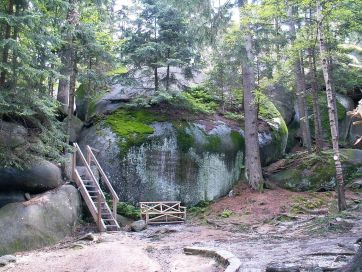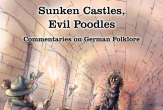Excerpts from Wahles-Books: Difference between revisions
Created page with "{{Sidebar|Felsenlabyrinth 10 db.jpg|View of the "Felsenlabyrinth Luisenburg" rock formation.|Excerpts from Wahles-Books|12|Bavaria|{{Coordinates|50.015556,11.858611}}|{{Coordinates|50.01208,11.99209}}|{{Coordinates|49.992792,11.991975}}}} “Forms and colors of the gold grains as described by Sebastian Berso in his Wahles-Book. 1) Many gold grains are red, like rusting iron; 2) many are like garnets, dark, transparent; 3) many are smoothly spherical; 4) many are like pe..." |
(No difference)
|
Revision as of 18:52, 24 September 2025

|
| Geographic Coordinates: 50° 0' 56.00" N, 11° 51' 31.00" E |
“Forms and colors of the gold grains as described by Sebastian Berso in his Wahles-Book. 1) Many gold grains are red, like rusting iron; 2) many are like garnets, dark, transparent; 3) many are smoothly spherical; 4) many are like peas; 5) many are like beans; 6) many are like pitch, but are also good.”
“Of the Fichtelsee lake Giovanni Carnero (a Venetian) as well as Joh. Schott write: This lake can be found in the lands of the Margrave, high up in the wetlands, and its bottom could not be found even at 40 fathoms. If someone dug into the ground at the top of the mountain to a depth of a span, they would find remarkably green stones. If they were heated with embers, they would turn red, and, when they were put next to silver, both of these stones would turn to pure gold of a kind undiscovered by all mankind until now.
As a side note, the same Venetian claims that gold lies on many mountains in the Fichtel Mountains like stone heaps on the ground.”
“Luchsburg near Wunsiedel. This mountain area near Wunsiedel in the Fichtelberg region is located at an unreachable, terrible height. Within this area, there are old mine entrances and underground tunnels, and within them gold and silver can be found. This is near the old castles which used to be the abodes of the robber knights of the House of Losburg, from which the mountain derives its name.
Outside of one of the castles, on the right side from the main gate looking outwards, there is an old underground chamber, or cellar, within the earth. Before it lies a very large stone, and within it is a very large iron chest with an incredible treasure of gold, silver, and jewels. This lies on top of a square copper cauldron, which is filled with a variety of guilder coins and is one ell high and two ells wide. Within, there are also a golden crown and beautiful jewels with gems, which the lords of the von Losburg line once stole from a king and buried there when the castle was destroyed. For those who want to search for it should look beneath the stairs. At this spot, there is a foursquare hole in which the treasure can be found, and, for this reason, the steps of the stairs must be broken off from the uppermost to the lowest one at the base of the stairs. It is best to retrieve the treasure on Epiphany Sunday. Probatum est. Carnero. I, for my part, hold that if this were to be true, that if there had ever been such a treasure here, then Carnero and his accomplices would have stolen it a long time ago and, at the very least, broken up the stairs. Thus, committing to such an effort would be pointless.”
“Kössein, a stream which flows into the Trebenitz near Redwitz, has its source at a strong well. Within are blackish grains, some as large as a pea and some smaller. The well-head throws these up into the air like sand in its center due to the force of the outflow. No one knows of them, but they contain a lot of gold. After it is cleaned, a third of the material is dissolved, and if the rest is carried to a goldsmith, they will pay nine Reichstalers for the pound. Carnero. In August of the year 1699, a farmer led me to this site who assured me that the Walloonish bearers of heckling combs and mousetraps had been seen there many times. I actually did find an old tin pan next to those grains, but how valuable they really were I cannot say.”
[to be continued]
Source: Zapf - Der Sagenkreis des Fichtelgebirges, p. 98ff
 Sunken Castles, Evil Poodles: Commentaries on German folklore. Get the book for further context and explanatory commentary! |